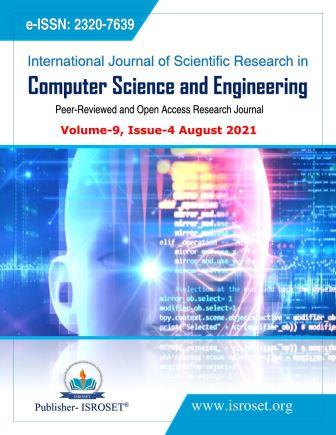IoT and Personal Data Protection
Keywords:
personal data, privacy, PDPAAbstract
IoT is the most evolving technology ever. In short period of time, there are so many devices related to IoT have come into market. Devices like smart watches, lenses, fitness brand, microchips and other more. IoT means a physical device powered by the Internet with an embedded system of sensors, actuators and a networking device that exchanges and collects data. All the devices need different application to run. Any user who uses this application has to enter the data to enhance service of the device. Similarly, to see the security and nodes of IoT devices that have been compromised, collect all this information of malicious activity, it has become a top priority of the IoT network. If we insert data from any application into the device, the user shares this data. The user`s privacy is at risk whenever the user shares data. So this paper presents how you can protect a user`s personal data. Inside this paper we will look at different methods of how to protect personal data. Personal data administrators are being used to monitor and handle user data exchange, as well as inference prevention techniques. It can also equate the PDPA to its counterparts in other countries using a comparative approach.
References
SN. Friedman, J. B. Rowe, D. J. Reinkensmeyer, M Bachman,The manumeter: A wearable device for monitoring daily use of the wrist and fingers. IEEE journal of biomedical and health informatics, 18(6), 1804-1812, 2014.
Department of computer science, Bioengineering, Robotics and systems Engineering University of Genoa, Italy. A Framework for Personal Data Protection in IoT.
Z. Huo,M. Xiaofeng, Z. Rui, "Feel free to check-in: Privacy alert against hidden location inference attacks in GeoSNs.", International Conference on Database Systems for Advanced Applications, Springer Berlin Heidelberg, 2013.
Department of Computing and Cyber Security, Texas A&M University, San Antonio, TX 78224, USA. IoT Privacy and Security: Challenges and Solutions.
Meng, Y.; Zhang, W.; Zhu, H.; Shen, X.S. Securing consumer IoT in the smart home: Architecture, challenges, and countermeasures. IEEE Wirel. Commun. 25, 53–59, 2018.
Siby, S.; Maiti, R.R.; Tippenhauer, N.O. Iotscanner: Detecting privacy threats in IoT neighborhoods. In Proceedings of the 3rd ACM International Workshop on IoT Privacy, Trust, and Security, Abu Dhabi United Arab Emirates, pp. 23–30, 2 April 2017.
Hassan, W.H. Current research on Internet of Things (IoT) security: A survey. Comput. Netw. 148,283–294, 2019.
Leloglu, E.Areviewof security concerns in Internet of Things. J. Comput. Commun. 5, 121–136, 2016.
Sadeghi, A.-R.; Wachsmann, C.; Waidner, M. Security and privacy challenges in industrial internet of things. In Proceedings of the 2015 52nd ACM/EDAC/IEEE Design Automation Conference (DAC), San Francisco, CA, USA, 8–12 pp. 1–6, June 2015.
Bertino, E., Choo, K.-K. R., Georgakopolous, D., & Nepal, S. (2016). Internet of Things (IoT): Smart and Secure Service Delovery. ACM Transactions on Internet Technology, 16(4), 1–7. http://doi.org/10.1145/3013520
Raza, S., Helgason, T., Papadimitratos, P., & Voigt, T. (2017). SecureSense: End-to-end secure communication architecture for the cloud-connected internet of things. Future Generation Computer Systems. http://doi.org/10.1016/j.future.2017.06.008
Z. Cai, Z. He, X. Guan, Y. Li, "Collective Data-Sanitization for Preventing Sensitive Information Inference Attacks in Social Networks", IEEE Transactions on Dependable and Secure Computing, 5971(c), 2016.
Y. Sun, L. Yin, L. Liu, S. Xin, "Toward inference attacks for kanonymity", Personal and Ubiquitous Computing, 18(8), 1871- 1880, 2014
S. Chakraborty, C. Shen, K. R. Raghavan, Y. Shoukry, M. Millar, M. Srivastava, "ipShield : A Framework For Enforcing Context-Aware Privacy", In 11th USENIX Symposium on Networked Systems Design and Implementation (NSDI 14), pp. 143-156. 2014.
The Influence of Privacy and Security on the Future of IoT Mihaela M?d?lina ANGHEL, Petru IANC, Marian ILEANA, Laura Iulia MODI Bucharest University of Economic Studis, Romania Informatica Economic? vol. 24, no. 2/202
H. Orman, Blockchain: The emperors new pki?, IEEE Internet Computing, vol. 22, no. 2, pp. 23–28, 2018.
Downloads
Published
How to Cite
Issue
Section
License

This work is licensed under a Creative Commons Attribution 4.0 International License.
Authors contributing to this journal agree to publish their articles under the Creative Commons Attribution 4.0 International License, allowing third parties to share their work (copy, distribute, transmit) and to adapt it, under the condition that the authors are given credit and that in the event of reuse or distribution, the terms of this license are made clear.







